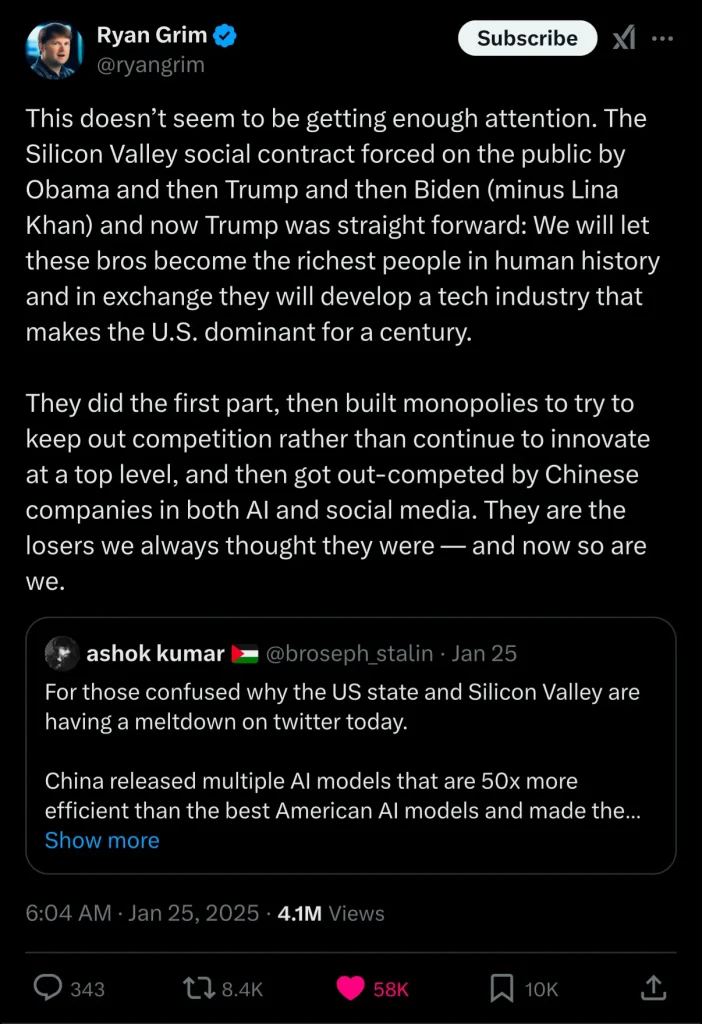The End of the AI Supremacy Race: A New Era of Global Competition
In a dramatic shift that has reshaped the artificial intelligence landscape, recent developments from Chinese tech companies have effectively ended any notion of US dominance in AI development. The emergence of DeepSeek, in particular, has demonstrated that the path to AI advancement isn’t necessarily paved with billions of dollars in infrastructure investment.
The Rise of DeepSeek
In late December 2024, DeepSeek, a company initially focused on quantitative trading, stunned the tech world by producing a near state-of-the-art language model at approximately 1/50th of the traditional training costs. This achievement immediately positioned them alongside industry giants like OpenAI, Google, and Anthropic (Claude). Their follow-up release, R1, provided a competitive alternative to OpenAI’s latest offerings, gaining particular favor among researchers due to its transparency about internal processes.
The Implications for OpenAI
This development has hit OpenAI particularly hard. Just two years after ChatGPT’s launch and their landmark deal with Microsoft, OpenAI’s position as the undisputed leader in AI has eroded significantly. The company faces multiple challenges:
- Their technical advantage is no longer clear-cut
- Competitors are undercutting their pricing
- Customer loyalty is weakening as viable alternatives emerge
- Their relationship with Microsoft has reportedly become strained
- Key personnel, including co-founders and their CTO, have departed
- The much-anticipated GPT-5 remains unreleased
Most telling is OpenAI’s recent shift toward focusing on user interface improvements rather than core technical advances, suggesting difficulties in maintaining their technical edge. Their revenue, reportedly around $5 billion, appears modest compared to their substantial investments, and recent price cuts in response to DeepSeek’s emergence indicate growing competitive pressure.
Impact on Nvidia and Hardware Dependencies
DeepSeek’s breakthrough has significant implications for Nvidia, the dominant provider of AI training hardware. The demonstration that large language models can be trained more efficiently challenges the assumption that success in AI requires massive arrays of top-tier processors. This could reduce demand for Nvidia’s premium chips, which have been crucial to their recent market success.
The development also questions the wisdom of massive investments in power and data centers built around these high-end processors. If DeepSeek’s approach proves replicable, it could fundamentally alter the hardware requirements for advanced AI development.
The CHIPS Act Backfire
The situation highlights potential flaws in US policy, particularly regarding the CHIPS Act. Designed to slow China’s AI progress through export controls on advanced processors, the policy may have inadvertently accelerated Chinese innovation. Forced to work with limited access to top-tier hardware, Chinese companies have developed more efficient approaches to AI model training.
This outcome suggests that the Biden administration’s gamble on maintaining US technological supremacy through hardware restrictions may have backfired. Rather than securing a lasting advantage, the policy appears to have spurred Chinese companies to develop innovative workarounds, potentially undermining the long-term competitiveness of US companies like Nvidia.

Miles Brundage says – Certainly there’s a lot you can do to squeeze more intelligence juice out of chips, and DeepSeek was forced through necessity to find some of those techniques maybe faster than American companies might have. But that doesn’t mean they wouldn’t benefit from having much more. That doesn’t mean they are able to immediately jump from o1 to o3 or o5 the way OpenAI was able to do, because they have a much larger fleet of chips.
The Consumer Perspective
For consumers, these developments could bring significant benefits through reduced costs for AI services. However, this cost reduction might come with its own risks. In an unregulated environment with intense global competition, rapid development cycles could exacerbate existing concerns about:
- Misinformation
- Biased outputs
- Privacy breaches
- Potential misuse by malicious actors
Meta’s Role and Strategic Mistakes
One factor in China’s rapid advancement that warrants investigation is Meta’s decision to open-source their language models. DeepSeek reportedly built upon Meta’s Llama model, raising questions about whether US companies’ commitment to open-source development inadvertently accelerated foreign competitors’ progress.
The Future Landscape
Looking ahead, the AI industry appears to be entering a period of global parity rather than single-nation dominance. Key predictions for the next three years include:
- Incremental Advances: Future improvements will likely be more gradual and quickly matched by competitors. Even when breakthrough models like GPT-5 eventually emerge, any technical advantage will be short-lived.
- Efficiency Gains: While models will become more efficient and less expensive to develop and operate, fundamental challenges like hallucinations and reliability issues will persist.
- AGI Remains Distant: Despite Silicon Valley optimism, artificial general intelligence is unlikely to emerge by 2027, as resources continue to be focused on refining existing approaches rather than developing truly novel solutions.
Breaking the LLM Paradigm
The path forward for regaining clear leadership in AI development likely requires thinking beyond the current large language model paradigm. LLMs have become too well understood for any single player to maintain a significant advantage. Their inherent limitations – opacity, unwieldiness, and debugging difficulties – suggest that breakthrough advances will require fundamentally new approaches.
Content Limitations & Censorship
However, DeepSeek’s technology isn’t without limitations. Testing reveals that the platform actively restricts responses to politically sensitive topics, particularly those concerning Chinese politics and history. Questions about events like Tiananmen Square or discussions about Taiwan receive carefully crafted responses aligned with Chinese government positions, or users encounter polite deflections. This aspect of the platform highlights the ongoing challenge of balancing technological advancement with content control in different regulatory environments.
The Winner’s Circle
Success in the AI race will ultimately go to those who foster genuine innovation rather than those who simply accumulate the most computing power. This opens the possibility for leadership to emerge from unexpected sources, including countries less invested in current LLM orthodoxy and more willing to explore radical new approaches.
Regulatory and Policy Implications
These developments suggest the need for a revised approach to AI policy and regulation. Rather than focusing on hardware restrictions and infrastructure investments, policies might better serve national interests by:
- Encouraging diverse approaches to AI development
- Supporting fundamental research in alternative AI architectures
- Fostering international collaboration while protecting core innovations
- Developing frameworks for responsible AI deployment
The Role of Private Industry
The private sector’s response to these changes will be crucial. Companies may need to:
- Diversify their AI research beyond current LLM approaches
- Focus on efficiency and optimization rather than raw computing power
- Develop unique applications and use cases rather than competing on model size
- Invest in alternative AI architectures and approaches
Lessons for the Future
The rapid erosion of US technical advantage in AI development offers several key lessons:
- Technical superiority is increasingly temporary in the AI field
- Innovation can emerge from constraints rather than abundance
- Open-source development has accelerated global AI progress
- Hardware advantages alone cannot maintain leadership in AI
- The path to AI advancement may require fundamental rethinking rather than incremental improvement
Conclusion
The end of the AI supremacy race marks the beginning of a new era in artificial intelligence development. Rather than a single dominant player, we’re likely to see a more distributed landscape where innovation comes from multiple sources and technical advantages are shorter-lived. This new reality calls for a fundamental reassessment of how we approach AI development, regulation, and investment.
Success in this new environment will require more than just technical capability or computational resources. It will demand creative approaches, efficient resource utilization, and perhaps most importantly, the willingness to explore entirely new paradigms in artificial intelligence. The future leaders in AI might not be those who perfect current approaches, but those who discover entirely new ones.




